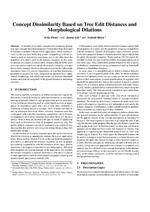Concept Dissimilarity Based on Tree Edit Distances and Morphological Dilations
Aus International Center for Computational Logic
Concept Dissimilarity Based on Tree Edit Distances and Morphological Dilations
Felix DistelFelix Distel, Jamal, AtifJamal, Atif, Isabelle BlochIsabelle Bloch
Felix Distel, Jamal, Atif, Isabelle Bloch
Concept Dissimilarity Based on Tree Edit Distances and Morphological Dilations
In Torsten Schaub, eds., Proceedings of the 21st International Conference on Artificial Intelligence (ECAI'14), 2014
Concept Dissimilarity Based on Tree Edit Distances and Morphological Dilations
In Torsten Schaub, eds., Proceedings of the 21st International Conference on Artificial Intelligence (ECAI'14), 2014
- KurzfassungAbstract
A number of similarity measures for comparing description logic concepts have been proposed. Criteria have been developed to evaluate a measure's fitness for an application. These criteria include on the one hand those that ensure compatibility with the semantics, such as equivalence soundness, and on the other hand the properties of a metric, such as the triangle inequality. In this work we present two classes of dissimilarity measures that are at the same time equivalence sound and satisfy the triangle inequality: a simple dissimilarity measure, based on description trees for the lightweight description logic EL{}; and an instantiation of a general framework, presented in our previous work, using dilation operators from mathematical morphology, and which exploits the link between Hausdorff distance and dilations using balls of the ground distance as structuring elements. - Forschungsgruppe:Research Group: AutomatentheorieAutomata Theory
@inproceedings{ DiAtBl-ECAI14,
address = {Prague, Czech Republic},
author = {Felix {Distel} and Jamal, {Atif} and Isabelle {Bloch}},
booktitle = {Proceedings of the 21st International Conference on Artificial Intelligence (ECAI'14)},
editor = {Torsten {Schaub}},
title = {Concept Dissimilarity Based on Tree Edit Distances and Morphological Dilations},
year = {2014},
}
